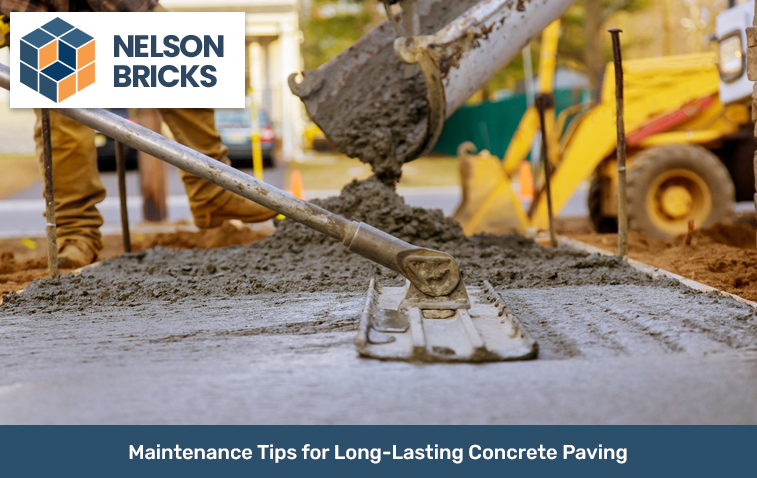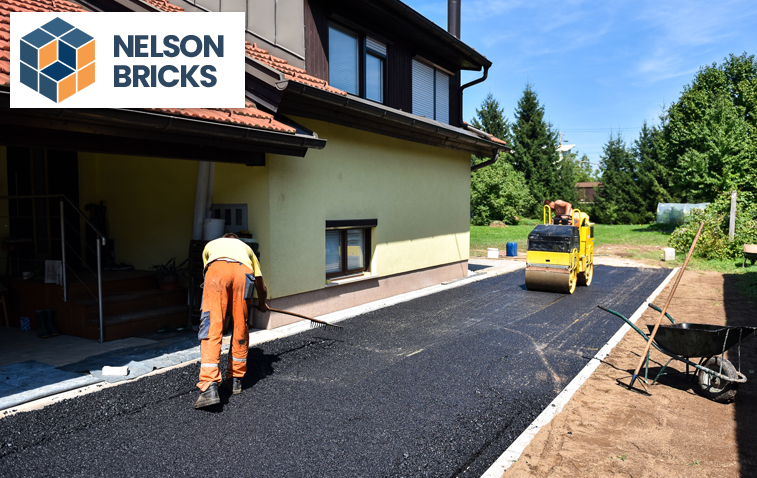Maintenance Tips for Long-Lasting Concrete Paving
Concrete paving is a durable and versatile choice for driveways, patios, sidewalks, and other outdoor surfaces. It offers strength, stability, and a clean look, making it a popular option for homeowners and businesses alike. However, to ensure that your concrete paving lasts for many years, proper maintenance is essential.
While concrete is a strong material, exposure to weather, traffic, and natural wear and tear can lead to cracks, stains, and other issues over time. With regular maintenance and a few simple practices, you can keep your concrete paving in great condition for years to come. This guide will walk you through some essential maintenance tips that will help extend the life of your concrete paving.

Clean the Surface Regularly
Keeping your concrete paving clean is one of the most important steps in maintaining its appearance and durability. Dirt, debris, and stains can build up over time, causing the surface to look dull and uninviting. Regular cleaning not only improves the look of your paving but also helps prevent damage.
Use Simple Cleaning Methods
You don’t need fancy equipment to clean your concrete paving. A broom, water, and mild soap will do the job. For regular maintenance, sweeping the surface once a week and hosing it down with water will keep dirt and debris from accumulating.
Simple Explanation:
- Sweep Regularly: A quick sweep keeps dirt and debris off the surface.
- Mild Soap: Use mild soap and water to remove stains.
- Hose It Down: A hose can easily wash away loose dirt and grime.
Pressure Washing for Deep Cleaning
Every once in a while, give your concrete paving a deep clean with a pressure washer. Pressure washing removes built-up grime, mildew, and stains that regular cleaning can’t reach. Just be careful not to use too much pressure, as it can damage the surface if not done correctly.
Simple Explanation:
- Pressure Washing: For deep cleaning, use a pressure washer.
- Remove Grime: It helps remove deep stains and mildew.
- Be Careful: Don’t use too much pressure to avoid damaging the concrete.
Seal the Surface for Protection
Sealing your concrete paving is one of the best ways to protect it from damage. A good sealer acts as a barrier against moisture, oil, and other substances that can cause stains or cracks. Sealing also enhances the appearance of the concrete, giving it a fresh and polished look.
Choose the Right Sealer
Not all sealers are the same. Choose a high-quality concrete sealer that is designed for outdoor surfaces. You can select from water-based or solvent-based sealers depending on your needs. It’s best to apply the sealer every 2 to 3 years to keep your paving in top shape.
Simple Explanation:
- Select the Right Sealer: Use a high-quality sealer designed for outdoor concrete.
- Water-Based or Solvent-Based: Choose based on your specific needs.
- Apply Every Few Years: Reapply every 2 to 3 years to maintain protection.
How to Apply the Sealer
Before applying the sealer, make sure the surface is clean and dry. Use a roller or sprayer to apply a thin, even coat across the surface. Let it dry completely before allowing any foot or vehicle traffic on it.
Simple Explanation:
- Clean First: Make sure the concrete is clean and dry.
- Even Coat: Apply the sealer in an even layer with a roller or sprayer.
- Let It Dry: Allow the sealer to dry fully before using the paved area.
Fix Cracks and Damage Early
Cracks are a common issue with concrete paving, especially after years of exposure to the elements. If left untreated, small cracks can grow larger and lead to more significant problems. Repairing cracks early helps prevent further damage and extends the life of your paving.
Identify Cracks Early
Check your concrete paving regularly for signs of cracks or damage. The earlier you catch a crack, the easier it will be to fix. Small cracks can often be filled with concrete patching compound or crack filler.
Simple Explanation:
- Look for Cracks: Check for cracks regularly to catch them early.
- Fill Small Cracks: Use a patching compound to fill in small cracks.
- Prevent Bigger Problems: Fixing cracks early stops them from growing larger.
Repair Larger Cracks
For larger cracks or damage, you may need to use a concrete repair product or even replace sections of the paving. It’s important to address these issues as soon as possible to prevent moisture from seeping in and causing more extensive damage.
Simple Explanation:
- Large Cracks: Use a concrete repair product for bigger cracks.
- Repair Quickly: Fix large cracks quickly to avoid more damage.
- Replace Sections: In some cases, replacing damaged sections may be necessary.
Control Water and Drainage
Water is one of the biggest enemies of concrete paving. Standing water can seep into cracks and weaken the structure, while poor drainage can cause erosion or damage to the base of the paving. Ensuring proper drainage and controlling water flow are essential to protecting your concrete.
Prevent Standing Water
Make sure that water doesn’t collect on the surface of your concrete paving. Check for low spots where water tends to pool and fix them to ensure proper drainage.
Simple Explanation:
- No Standing Water: Prevent water from pooling on the surface.
- Check for Low Spots: Fix any low spots to improve drainage.
- Proper Drainage: Ensure that water flows away from the paving.
Direct Water Away
It’s also important to direct water away from your concrete paving. Gutters, downspouts, and drains should be positioned so that water is not flowing onto the concrete.
Simple Explanation:
- Direct Water Elsewhere: Make sure water is directed away from the concrete.
- Use Gutters and Drains: Place gutters and drains to manage water flow.
- Protect the Base: Proper drainage helps protect the base of the concrete.
Protect the Paving from Heavy Loads
Concrete is strong, but it can still be damaged by excessive weight. Heavy vehicles, machinery, or furniture can cause cracks or dents in the surface. By protecting your concrete from heavy loads, you can help it last longer.
Avoid Parking Heavy Vehicles
Try not to park heavy trucks or machinery on your concrete paving for extended periods. If you must, use plywood or rubber mats to distribute the weight evenly and prevent damage.
Simple Explanation:
- No Heavy Parking: Avoid parking heavy vehicles on the concrete.
- Use Mats: Use rubber mats or plywood to protect the surface.
- Prevent Cracks: Distribute the weight to avoid cracks and dents.
Use Furniture Pads
If you have outdoor furniture on your concrete patio, use furniture pads or mats under the legs. This prevents the furniture from scratching or damaging the surface when moved.
Simple Explanation:
- Furniture Pads: Use pads under furniture legs to protect the surface.
- No Scratches: Prevent scratching or denting when moving furniture.
- Protect Your Patio: Simple pads help protect your patio from wear and tear.
Remove Stains Promptly
Concrete can absorb stains from oil, grease, and other substances if they’re not cleaned up quickly. To keep your concrete paving looking clean and new, remove stains as soon as you notice them.
Use a Mild Cleaner
For most stains, a mixture of mild detergent and water is enough to clean the surface. Scrub the area gently with a brush and rinse with clean water.
Simple Explanation:
- Mild Cleaner: Use mild detergent and water to clean stains.
- Scrub Gently: Use a brush to scrub the area gently.
- Rinse with Water: Rinse with clean water after scrubbing.
Remove Tough Stains
For tougher stains, such as oil or grease, you may need a specialized concrete cleaner. These cleaners are designed to lift stains from the porous surface of the concrete. Be sure to follow the product’s instructions carefully.
Simple Explanation:
- Tough Stains: Use a concrete cleaner for stubborn stains.
- Lift Stains: Specialized cleaners help remove deep stains.
- Follow Instructions: Always follow the cleaner’s instructions for the best results.
Keep Plants and Roots at Bay
If your concrete paving is near trees, plants, or shrubs, the roots can grow under the concrete and cause it to crack or shift. Keeping plants and roots away from the edges of the paving can help prevent this issue.
Trim Nearby Plants
Trim back any plants or shrubs that are growing near your concrete paving. This helps prevent their roots from spreading under the concrete and causing damage.
Simple Explanation:
- Trim Plants: Keep plants trimmed away from the concrete.
- Prevent Root Damage: Roots can grow under the concrete and cause cracks.
- Protect the Edges: Trimming helps protect the edges of your paving.
Install Root Barriers
If you have trees near your concrete paving, consider installing root barriers. These barriers prevent tree roots from growing toward the concrete and damaging it.
Simple Explanation:
- Root Barriers: Use root barriers to protect your concrete from tree roots.
- Prevent Cracks: Barriers stop roots from cracking the concrete.
- Long-Term Protection: This provides long-term protection for your paving.
Maintaining your concrete paving doesn’t have to be complicated. With regular cleaning, sealing, and a few preventive measures, you can keep your paving looking great and lasting for many years. By addressing small issues like cracks and stains early, you can avoid more extensive damage down the road. Protecting your concrete from heavy loads, controlling water, and keeping plants at bay will also help ensure its longevity. Concrete is a durable material, but with proper care, you can make it last even longer, saving you time and money in the long run.
FAQ
You should seal your concrete paving every 2 to 3 years. This helps protect the surface from moisture, stains, and other damage, keeping it looking fresh and lasting longer.
Yes, if done incorrectly. High-pressure settings can damage the surface of the concrete. It’s best to use a low-pressure setting and avoid holding the nozzle too close to the surface.
Cracks can be caused by natural wear and tear, exposure to extreme weather, or heavy loads. It’s important to repair cracks early to prevent them from spreading and causing further damage.
Trim plants regularly to keep them away from the concrete. For larger trees, consider installing root barriers to prevent roots from growing under the concrete and causing cracks.


